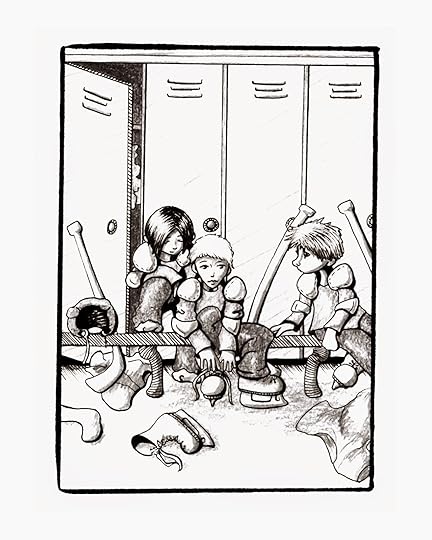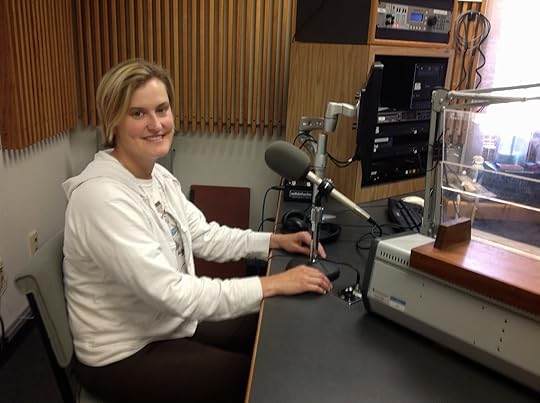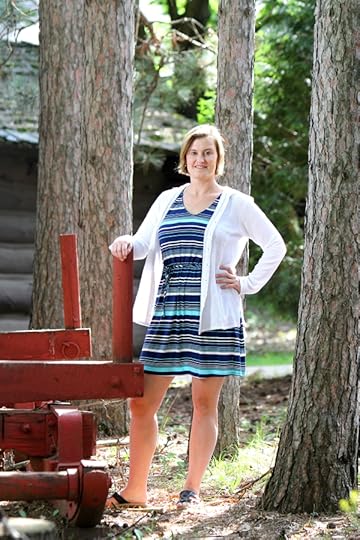Caroline Akervik's Blog, page 10
September 22, 2014
Sneak Peek of Calvin the Cookie Maker illustrations - Hopefully to be released in October of this year!
Published on September 22, 2014 09:09
August 12, 2014
At Spectrum West for the WPR Central Time Interview
Published on August 12, 2014 13:57
August 7, 2014
Public Radio Interview - Tuesday, August 12th from 4:00 to 4:15 PM
I will be interviewed by Veronica Rueckert for Central Time on Wisconsin Public Radio on Tuesday, August 12th, from 4:00 to 4:15 PM CT. We will be discussing White Pine. Please listen in.
Thanks!
Thanks!
Published on August 07, 2014 14:30
The best view from my writing desk
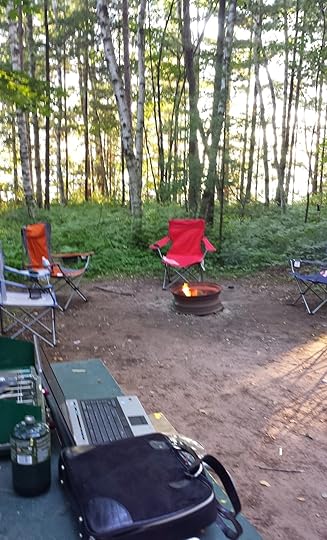 I debate bringing my laptop with me when we go camping. I worry that I am taking away from my family by taking the time to write. Sometimes, it's too hot for the dog to go on the boat, then I stay back at the campsite and write. It's very pleasant listening to the wind in the trees, very inspiring...
I debate bringing my laptop with me when we go camping. I worry that I am taking away from my family by taking the time to write. Sometimes, it's too hot for the dog to go on the boat, then I stay back at the campsite and write. It's very pleasant listening to the wind in the trees, very inspiring...
Published on August 07, 2014 14:24
July 14, 2014
"Timber Tales" by Tom Giffey
Published on July 14, 2014 07:16
Spectrum West Interview with Jim Oliver, July 3rd, 2014
I am a huge fan of public radio and, recently, I had the great pleasure of being interviewed by Jim Oliver on Spectrum West about White Pine. This program is devoted to the Arts and Culture of Wisconsin. Here is the link to the archived program: Spectrum West for July 3rd, 2014.
Published on July 14, 2014 07:01
June 2, 2014
Review of Ken's War by B. K. Fowler
Over the weekend, I had the great pleasure to read B. K. Fowler’s Young Adult coming-of-age story, Ken’s War. As a school librarian and the mother of two boys (and a girl), I am always on the lookout for books that will appeal to boys, particularly adolescents. I believe that Ken’s War will hold great appeal for teenaged boys who are looking action and adventure and want characters to whom they can relate.
The story line of Ken’s War is complex. Set in the Vietnam era, Ken Paderson and his father have moved to Japan because his father, who is in the military, has been reassigned there. Ken is out-of-sorts. Struggling with culture shock, Ken is angry with his father for uprooting him and keeping him in the dark on many issues, including his grandparents’ death. His mother is, at first, out of the picture.
There is a secondary story line about a budding but forbidden relationship between Ken and Yasuko, a young Nisei woman. This flirtation proves as fragile and as rare as a white macaque monkey.
Ken, like many young men, is struggling to construct an identity and make sense of his world. Adding to this heady brew of hormones and clashing cultures, are a smuggling ring, a martial arts master, and a revelatory trip home to the states.
Ken, like many adolescents, particularly ones whose families are going through changes, is at war with nearly everyone and everything, including himself. In the course of the novel, Ken comes to empathize with others around him, including his father, and to see the world through other’s eyes.
The strength is B. K. Fowler’s writing lies in her ability to capture the essence of an image or a moment. Ken’s War, like the potent taste of dried tea leaves on the tongue, lingers in one’s mind.
The story line of Ken’s War is complex. Set in the Vietnam era, Ken Paderson and his father have moved to Japan because his father, who is in the military, has been reassigned there. Ken is out-of-sorts. Struggling with culture shock, Ken is angry with his father for uprooting him and keeping him in the dark on many issues, including his grandparents’ death. His mother is, at first, out of the picture.
There is a secondary story line about a budding but forbidden relationship between Ken and Yasuko, a young Nisei woman. This flirtation proves as fragile and as rare as a white macaque monkey.
Ken, like many young men, is struggling to construct an identity and make sense of his world. Adding to this heady brew of hormones and clashing cultures, are a smuggling ring, a martial arts master, and a revelatory trip home to the states.
Ken, like many adolescents, particularly ones whose families are going through changes, is at war with nearly everyone and everything, including himself. In the course of the novel, Ken comes to empathize with others around him, including his father, and to see the world through other’s eyes.
The strength is B. K. Fowler’s writing lies in her ability to capture the essence of an image or a moment. Ken’s War, like the potent taste of dried tea leaves on the tongue, lingers in one’s mind.
Published on June 02, 2014 08:39
May 20, 2014
What if? The birth of a story idea
I was speaking with a third grade class yesterday and one of the children asked: "Where do you get the idea for a story? How do you start a new book? "
I answered the question somehow. It was only later, when I went for a walk, that I truly thought out my answer.
For me, a story starts with an image and then with a What if?
White Pine began with a visit to the Chippewa Valley Museum. I was sitting on a bench in the bunk house with my then third grader and he pointed out the lumberjack socks dangling from rail by the stove. The idea popped into my mind: What if a boy, one older than my son, had to go to work at a logging camp in the 1880s? Other questions followed that What if? Questions like: Why would he have to go? How would the other men treat him? And, would he want to go home after a winter in the Northwoods?
Once the kernel of an idea for a story starts to develop in my mind, I often stumble upon other images or moments that develop the story. I remember going geocaching with my kids one Saturday afternoon and one of the clues that led us to our cache was a historical marker. The marker stood by an old brick building which turned out to once have been a lumber company office and was one of the few remaining lumberjack era buildings left in the city of Eau Claire. So, the idea for the story continued to grow in my mind. For me, it is as if a story asks to be told, gives me frequent reminders, and if I don't jot them down in my Writer's Notebook, the entire thing can slip away and be lost in the cobwebs in my mind.
So, my advice for new or young writers is to be open to the What ifs that pop up around you. A story, once it starts in your mind, has a life and power all its own. Your characters will demand that certain things happen to them. They will make their own choices and choose their destinies. But you have to jot down the ideas, hold fast to threads of inspiration which slip through your mind, or you risk losing these inspirations.
It all starts with a What if.

I answered the question somehow. It was only later, when I went for a walk, that I truly thought out my answer.
For me, a story starts with an image and then with a What if?
White Pine began with a visit to the Chippewa Valley Museum. I was sitting on a bench in the bunk house with my then third grader and he pointed out the lumberjack socks dangling from rail by the stove. The idea popped into my mind: What if a boy, one older than my son, had to go to work at a logging camp in the 1880s? Other questions followed that What if? Questions like: Why would he have to go? How would the other men treat him? And, would he want to go home after a winter in the Northwoods?
Once the kernel of an idea for a story starts to develop in my mind, I often stumble upon other images or moments that develop the story. I remember going geocaching with my kids one Saturday afternoon and one of the clues that led us to our cache was a historical marker. The marker stood by an old brick building which turned out to once have been a lumber company office and was one of the few remaining lumberjack era buildings left in the city of Eau Claire. So, the idea for the story continued to grow in my mind. For me, it is as if a story asks to be told, gives me frequent reminders, and if I don't jot them down in my Writer's Notebook, the entire thing can slip away and be lost in the cobwebs in my mind.
So, my advice for new or young writers is to be open to the What ifs that pop up around you. A story, once it starts in your mind, has a life and power all its own. Your characters will demand that certain things happen to them. They will make their own choices and choose their destinies. But you have to jot down the ideas, hold fast to threads of inspiration which slip through your mind, or you risk losing these inspirations.
It all starts with a What if.

Published on May 20, 2014 08:10
May 7, 2014
Logging camp photo of one of the last lumberjack camps in Wisconsin
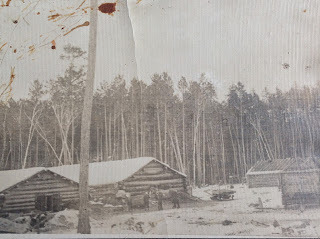 Here is a photo of one of the last logging camps in the state of Wisconsin. The picture was taken by Myles Smith in 1924 and the camp was near Park Falls, Wisconsin. Pat Smith of Smiles Books out of Chippewa Falls, his grandson, shared the picture with me. White Pine is set in the 1880s , but I imagine the camp to have looked much like this with the buildings of the camp set around a central clearing. #whitepine
Here is a photo of one of the last logging camps in the state of Wisconsin. The picture was taken by Myles Smith in 1924 and the camp was near Park Falls, Wisconsin. Pat Smith of Smiles Books out of Chippewa Falls, his grandson, shared the picture with me. White Pine is set in the 1880s , but I imagine the camp to have looked much like this with the buildings of the camp set around a central clearing. #whitepine
Published on May 07, 2014 12:49
April 30, 2014
Interview and White Pine giveaway at the Fire and Ice Blog
Please check out my interview and sign up for the White Pine giveaway by commenting on the Fire and Ice blog. I greatly appreciate your thoughts and comments!
Published on April 30, 2014 07:30

